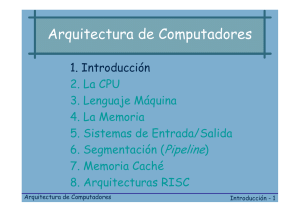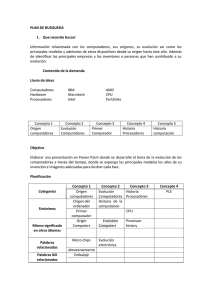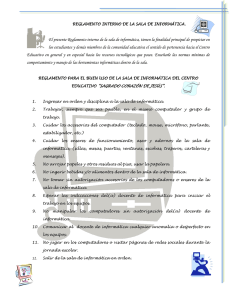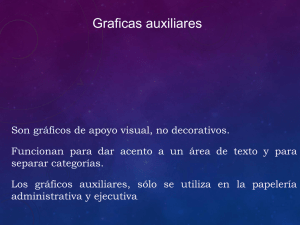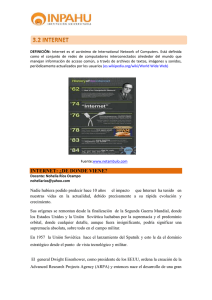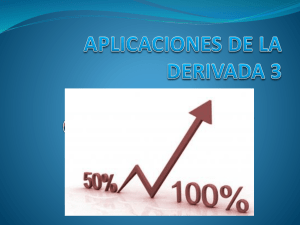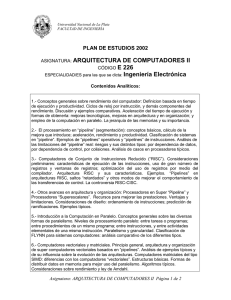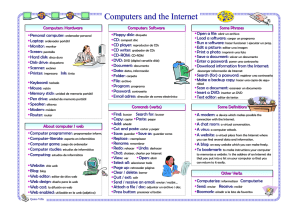Unit 1. Introduction - Arquitectura y Tecnología de Computadores
Anuncio
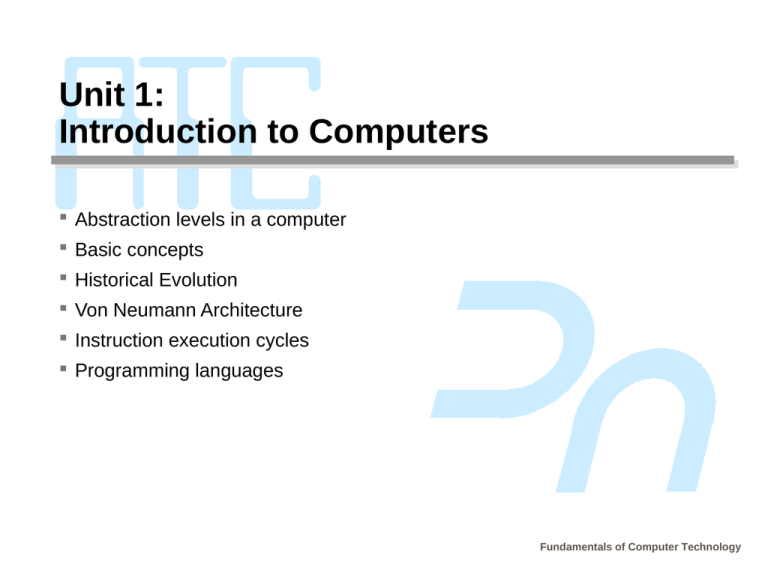
Unit 1: Introduction to Computers Abstraction levels in a computer Basic concepts Historical Evolution Von Neumann Architecture Instruction execution cycles Programming languages Fundamentals of Computer Technology Basic Bibliography Computer Organization and Design: The Hardware/Software Interface (Chapters 1,2) David A. Patterson, John L. Hennessy Fundamentos de los Computadores (Chapter 1) Pedro de Miguel Anasagasti Ed. Paraninfo Arquitectura de Computadores (Chapter 1) J. Antonio de Frutos, Rafael Rico Ed. Universidad de Alcalá Estructura de Computadores (Chapter 1) José Mª Angulo Usategui Ed. Paraninfo 2 Área de Arquitectura y Tecnología de Computadores Departamento de Automática Universidad de Alcalá Fundamentals of Computer Technology Abstraction levels in a computer Grado en Ingeniería Informática 3 Topic Subject Estructura y tecnología de computadores Fundamentos de tecnología de computadores Estructura y organización de computadores 1º Sistemas Operativos Sistemas Operativos Sistemas Operativos Avanzados 2º 3º Programación Fundamentos de programación Programación Programación Avanzada Ampliación de Programación Avanzada Procesadores del Lenguaje 1º 1º 4º 6º 5º Bases de Datos Bases de Datos Bases de Datos Avanzadas 4º 5º Área de Arquitectura y Tecnología de Computadores Departamento de Automática Universidad de Alcalá Term 3º Fundamentals of Computer Technology Abstraction levels in a computer Grado en Sistemas de la Información Topic 4 Subject Term Estructura y tecnología de computadores Fundamentos de tecnología de computadores 1º Sistemas Operativos Sistemas Operativos 2º Programación Programación y estructuras de datos 1º,2º,3º Bases de Datos Bases de Datos 4º,5º Área de Arquitectura y Tecnología de Computadores Departamento de Automática Universidad de Alcalá Fundamentals of Computer Technology Abstraction levels in a computer Grado en Ingeniería de Computadores Topic Estructura y tecnología de computadores 5 Subject Term Fundamentos de Tecnología de Computadores Estructura y Organización de Computadores Electrónica 1º Sistemas Operativos Sistemas Operativos Sistemas Operativos Avanzados 2º 3º Programación Fundamentos de Programación Programación Avanzada Procesadores del Lenguaje 1º 4º 6º Bases de Datos Bases de Datos 4º Arquitectura de Computadores Arquitectura e Ingeniería de Computadores 5º Área de Arquitectura y Tecnología de Computadores Departamento de Automática Universidad de Alcalá 3º 5º Fundamentals of Computer Technology Basic concepts Computer: machine that processes information Information in a computer: Bit Binary Digit: Basic information element (‘0’ or ‘1’) Byte Group of 8 bits (‘01101111’) Word Group of bits with which the computer works usually (8 bits, 16 bits, 32 bits or 64 bits) Units: 1 K 210 = 1024 1 M 210 · 210 = 1024 K 1 G 210 · (210 · 210) = 1024 M Instruction: Operation executed by the computer Data: Operand or result Program: Ordered instruction set tha performs a task 6 Área de Arquitectura y Tecnología de Computadores Departamento de Automática Universidad de Alcalá Fundamentals of Computer Technology Historical Evolution of Computers (I) Precedents Abacus: the first known invention to compute: Origin: centuries III- IV BC. Abacus Pascal arithmetical machine Develped by Blas Pascal (1642) Set of gear wheels numbered from 0 to 9. When passing from 9 to 0, one wheel pushed the next wheel one decimal. A memory system was included to store results 7 Área de Arquitectura y Tecnología de Computadores Departamento de Automática Universidad de Alcalá Arithmetical machine Fundamentals of Computer Technology Historical Evolution of Computers (II) Precedents Leibnitz machine (1671) It performed four arithmetical operations. • Difference engine Charles Babbage: Difference engine (1823) and analytical engine (1831): Executes any operation without human intervention It had a memory, arithmetic unit, gear system to transfer data, an an input/output device It used punched cards to be programmed It was never builted 8 Área de Arquitectura y Tecnología de Computadores Departamento de Automática Universidad de Alcalá Fundamentals of Computer Technology Historical Evolution of Computers (III) 1ª generation Experimental machines built with vacuum tubes Relay calculators: H. Aiken built MARK series 1941: ENIAC - Electronic Numerical Integrator and Calculator. Eckert y Mauchly General purpose computer with wired program MARK I 1945: First Draft of Report on the EDVAC - Electronic Discrete Variable Automatic Computer. Von Neumann. General purpose computer with stored program ENIAC 9 Área de Arquitectura y Tecnología de Computadores Departamento de Automática Universidad de Alcalá Fundamentals of Computer Technology Historical Evolution of Computers (IV) 2nd generation Comercial computers Built with transistors smaller, less heat dissipation, greater reliability ferrite memories Ferrite memories 10 Área de Arquitectura y Tecnología de Computadores Departamento de Automática Universidad de Alcalá UNIVAC (2ª gen.) Fundamentals of Computer Technology Historical Evolution of Computers (V) 3rd generation Families of computers: Minicomputers and supercomputers Built with integrated circuits smaller, cheaper, less heat dissipation Integrated circuit 11 Área de Arquitectura y Tecnología de Computadores Departamento de Automática Universidad de Alcalá IBM serie 370 (3ª gen.) Fundamentals of Computer Technology Historical Evolution of Computers (VI) 4th generation Personal Computers (PC) and work stations. Other applications: household appliances, music and video..., etc. Built with microprocessors and semicondutor memories. 1971: 1er microprocesador, INTEL 4004 80's information processing 90's-00's Communications (nets) 12 Área de Arquitectura y Tecnología de Computadores Departamento de Automática Universidad de Alcalá PC (4th gen.) Semiconductor memory Fundamentals of Computer Technology Historical Evolution of Computers (VII) 5th generation Microprocesador as basic element Massive parallelism Cummunication and connections among computers. Internet, WWW, email... 6th Generación? Miniaturization Parallelism Clusters Smart phones 13 Área de Arquitectura y Tecnología de Computadores Departamento de Automática Universidad de Alcalá Fundamentals of Computer Technology Historical Evolution of Computers (VIII) Summary Generation 1st 2nd 3rd 4th 5th Decades 1950 - 1960 1960 - 1970 1970 - 1980 1980 - 1990 1990 -200? Technology Vacuum tubes Transistors I.C. (SSI-MMI) I.C (LSI) I.C. (VLSI) Machines IBM 701 CDC 6600 PDP-8, PDP-11 Fujitsu M382 Cray X-MP Alpha 21164 Pentium ferrites Integrated circuits, caches Virtual memories Multiple level cache Machine FORTRAM, COBOL, ALGOL, PL1 BASIC, PASCAL High leevl C, C++, Java Computer comercial computer Minicomputer Microcomputer Characteristics Memory Languages Product 14 Williams tubes magnetic tapes Área de Arquitectura y Tecnología de Computadores Departamento de Automática Universidad de Alcalá Multiprocessor Vacuum tube, transistor, integrated circuit Fundamentals of Computer Technology Von Neumann Architecture Developed 1945 by John von Neumann Executes machine instructions from a program stored in the memory UCP Blocks: Memory Arithmetic-Logic Unit and registers Control Unit Input/Output unit REGISTROS PERIFÉRICO MEMORIA PERIFÉRICO PRINCIPAL UNIDAD UNIDAD ARITMÉTICA DE E/S PC UNIDAD DE CONTROL PERIFÉRICO Buses connect different parts: data bus, address bus, control bus 15 Área de Arquitectura y Tecnología de Computadores Departamento de Automática Universidad de Alcalá Fundamentals of Computer Technology Instruction execution cycles 1. Fetch CU generates signals to read a instruction from memory in the direction pointed by the program counter PC 2. Decode: CU receives instruction at IR and decodes it 3. Fetch operands: CU reads, if neccessary, operands from memory or registers 4. Executions and store results CU generates signals to execute instruction, and stores result in memory or registers 5. Program Counter update. CU updates the program counter to point to the next instruction to be executed. sequential working sequence modification PC modification bifurcation or jump 16 Área de Arquitectura y Tecnología de Computadores Departamento de Automática Universidad de Alcalá Fundamentals of Computer Technology Programming languages (I) High level language: -Set of instructions and syntaxis (PASCAL, C) -portable (same code compiles in different machines) Low Low level level language language Assembly language: Machine language: Instructions are represented with Instructions are written in binary symbolic names or mnemonics Difficult and a lot of mistakes Each instruction correspond Solution: high level language with a machine instruction and compile 17 Área de Arquitectura y Tecnología de Computadores Departamento de Automática Universidad de Alcalá Fundamentals of Computer Technology Lenguajes de programación (II) High level languagel (example: PASCAL) BEGIN Resta:= Minuendo - Sustraendo END. Machine language and assembler (Example: i80x86) A10000 2B060200 A30400 MOV AX, Minuendo SUB AX, Sustrayendo MOV Resta, AX Traduction from high level program to machine language are carried on by compilers and interpreters: Compiler high level language compiler 18 Machine language Assembler Área de Arquitectura y Tecnología de Computadores Departamento de Automática Universidad de Alcalá Assembler Fundamentals of Computer Technology
